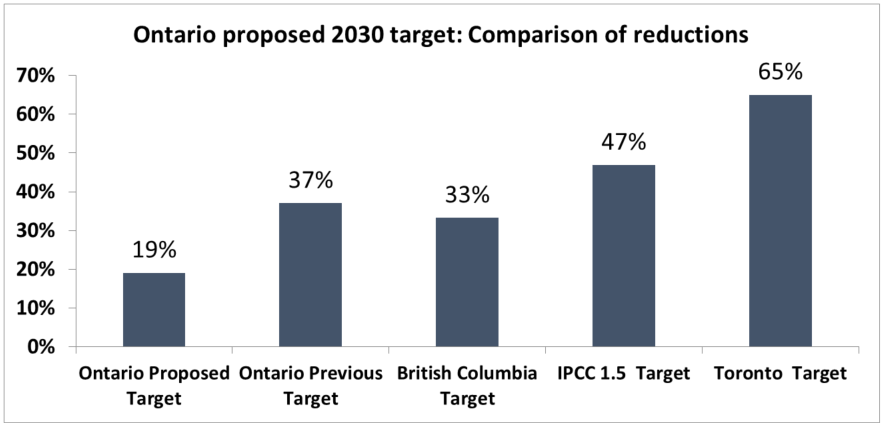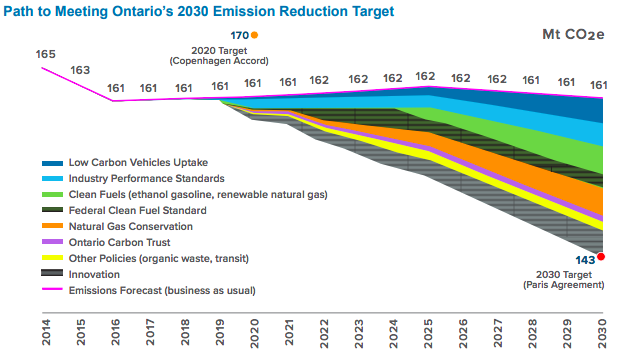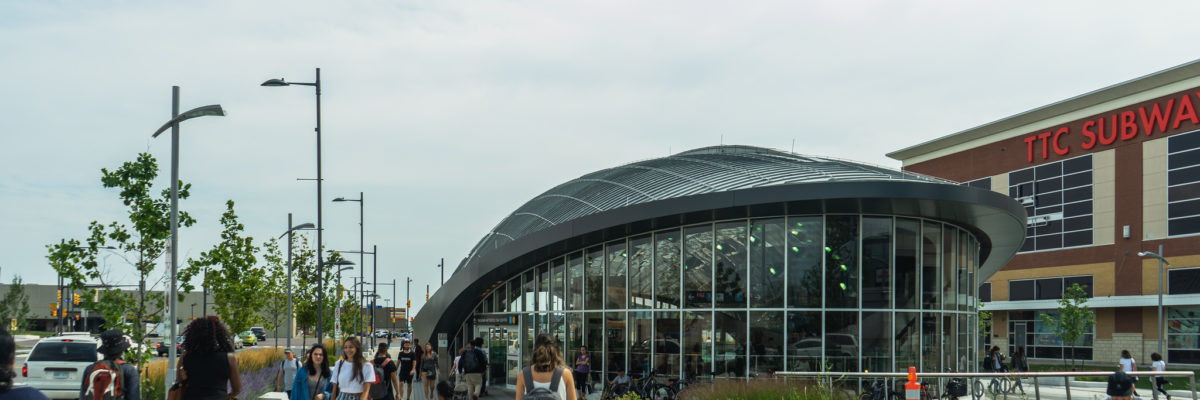Over 50% of Ontario’s carbon emissions originate in cities. This is determined by decisions we make about the energy we use in our homes and buildings, how we move people and goods around our cities, how we manage our waste, and how we plan and build for tomorrow. And cities are ‘ground zero’ for the impacts of climate change, which is one reason they have been leaders in advancing low-carbon solutions within the realm of their authority, like transit plans and curbside organics collection. But cities are so-called creatures of the province and depend significantly on provincial laws, policies, programs and investment to achieve their science-based targets for carbon reduction.
Unfortunately, Ontario’s proposed climate plan, Preserving and Protecting our Environment for Future Generations: A Made-in-Ontario Environment Plan, could weaken cities’ potential to contribute to climate protection in three ways. First, the lowered 2030 carbon reduction target and lack of a long-term target could put pressure on cities to weaken their ambition as well. Second, the availability of funding for urban climate solutions has been dramatically reduced. Third, there is little detail on the key strategies for reducing emissions. Some further detail on each of these concerns follows.
Ambitious targets needed to motivate short, medium and long-term action

Target reductions below 1990 baseline
Ontario’s proposed 2030 carbon reduction target is substantially weaker than the previous targets, less ambitious than targets set by other provinces and by various Ontario cities, and far less aggressive than what the most recent IPCC report indicates is necessary to stop dangerous climate change and stay below 1.5°C of warming.
The lack of a long-term, 2050 target is problematic. All stakeholders need to have a short, medium and long-term view to at least 80% emission reduction – net zero according to the IPCC — in order to avert irreversible impacts on our environmental, economic and social well-being. Choices we make between now and 2030 will have a major impact on Ontario’s 2050 emissions, such as decisions about new buildings and infrastructure. A long-term target is key to ensuring that these decisions are evaluated against that goal, or we risk getting locked into a pathway that is inconsistent with a stable climate. Each year we delay reductions, the harder, slower, and more expensive it gets (C40 Cities, Summary for Urban Policy Makers).
Funding and financing is needed to advance urban climate solutions
The plan proposes the Ontario Carbon Trust, an emissions reduction fund that will be capitalized with $400 million over four years to be invested in low-carbon solutions in a manner that leverages an additional $1 billion in private capital. While welcome, the provincial funding is 90% less than what was anticipated from the previous climate action plan. For cities that need capital to advance low-carbon solutions – like retrofitting our aging building stock, building out and electrifying transportation, and local distributed generation and storage – this represents a significant setback. The philosophy behind the fund is worthy, in fact, TAF itself is a revolving fund focused on urban carbon solutions, and there are various excellent models that the Ontario government could draw on including various US-based ‘green banks.’ However, the plan is short on details. Urgent attention should be given to fleshing it out and getting rolling in order to compensate for some lost momentum.
Details on key urban carbon reduction measures
The proposed plan includes modelling of how the targeted emissions reductions will be achieved (see below). While this includes many of the key measures included in other plans and studies (i.e. see the TransformTO actions here), there is very little detail on how the Province will realize these reductions. That is a concern for cities, which are working on many of the same opportunities and need to understand how the province will support their realization.

Source: Environment and Climate Change Canada, National Inventory Report 1990-2014: Greenhouse Gas Sources and Sinks in Canada, Part 3, Table A11-12, (2016), p.55
For instance, the plan relies on significant adoption of zero emissions vehicles which can definitely help cities achieve significant carbon reduction. But it is difficult to see a pathway for this being achieved given the province’s discontinuation of both purchase incentives and funding for charging infrastructure.
Although most of Ontario’s major industrial emitters operate outside urban areas, 19% of GTHA emissions are from large industrial emitters. The plan proposes implementation of industrial emissions standards through a regulatory system which appears to be similar to the Output Based Pricing System (OBPS) the federal government is implementing as part of the federal carbon pricing backstop. But the devil is in the details, and there are none at this point: when would this system take effect, what performance standards would be set, which sectors will be covered or exempted, and how it will interact with the federal OBPS set to take effect January 2019?
“Innovation” is slated to deliver 2.7 megatonnes of reduction per year by 2030 – 15% of the target – including from investing in technologies like energy storage and low carbon heating (e.g. electric heat pumps) that are important for urban carbon reduction. What’s missing is any detail on how this will be achieved. TAF’s experience has shown that supporting innovation requires a multifaceted focus on demonstrating, de-risking and commercializing technologies along with the policies, programs, and financing approaches needed to accelerate adoption and deployment at scale. Accelerating innovation is key to Ontario’s success but requires a holistic approach that goes well beyond the scope of conventional research and development funding programs.
TAF is pleased to see that the plan includes numerous other key urban carbon reduction strategies, like strengthening the building code, banning organic waste from landfills, and expanding natural gas conservation programs. However, no specific timelines or funding amounts are outlined. For example, an update of the Ontario Building Code (OBC) is overdue and expectations were for a near zero emissions target by 2030, yet the proposed plan only states that the OBC will be reviewed to support energy efficiency.
Cities with more aggressive targets may feel out on a limb and lacking some of the key provincially-controlled tools and levers for advancing urban reductions. There are a few ways we can maintain momentum and reach our goals while creating other community benefits. We may have to lean more heavily on municipal authorities like transportation planning, zoning, building permit approvals, waste management programs, and leverage the federal carbon tax funds that will be dedicated to municipal projects. This is not just a task for municipalities – the key is to engage all stakeholders such as developers, building and homeowners, and the transportation sector to integrate carbon reduction into their decisions and activities. We must also work together with the Province to ensure the inclusion of key measures and the most efficient allocation of funding. The proposed plan is still under consultation and you can send your feedback through the Environmental Registry.
This provincial climb-down poses challenges but it’s important to be optimistic about local capacity for urban climate action, and the ongoing interest to collaborate and engage senior levels of government. Like their counterparts all around the world, Ontario cities have been at the forefront of developing and implementing low-carbon solutions, and made remarkable strides. We have tremendous hope in their ability to engage the province where there is mutual benefit, to innovate and attract the participation of local citizens, institutions and businesses, and to lead the transition to a low-carbon economy.

